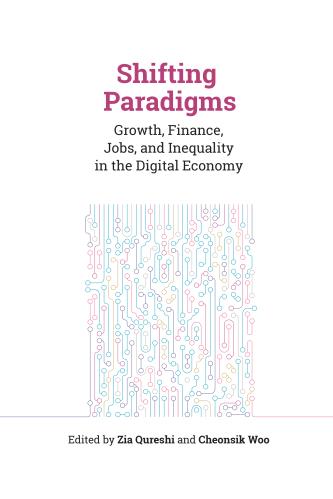This is the second in a series of blogs sharing insights from the new book “Shifting Paradigms: Growth, Finance, Jobs, and Inequality in the Digital Economy.”
Since the dawn of the Industrial Revolution, workers like the Luddites in 19th century Britain have feared that they will be replaced by machines and left permanently jobless. To date, these fears have been mostly wrong—but not entirely. In a chapter in “Shifting Paradigms,” I examine the implications of automation for jobs and wages.
Automation, jobs, and wages
On one hand, automation often creates as many jobs as it destroys over time. Workers who can work with machines are more productive than those without them; this reduces both the costs and prices of goods and services, and makes consumers feel richer. As a result, consumers spend more, which leads to the creation of new jobs.
On the other hand, there are workers who lose out, particularly those directly displaced by the machines and those who must now compete with them. Indeed, digital automation since the 1980s has added to labor market inequality, as many production and clerical workers saw their jobs disappear or their wages decline. New jobs have been created—including some that pay well for highly educated analytical workers. Others pay much lower wages, such as those in the personal services sector.
More broadly, workers who can complement the new automation, and perform tasks beyond the abilities of machines, often enjoy rising compensation. However, workers performing similar tasks, for whom the machines can substitute, are left worse off. In general, automation also shifts compensation from workers to business owners, who enjoy higher profits with less need for labor.
Very importantly, workers who can gain more education and training, either on the job or elsewhere, can learn new tasks and become more complementary with machines. For instance, while robots have displaced unskilled workers on assembly lines, they have also created new jobs for machinists, advanced welders, and other technicians who maintain the machines or use them to perform new tasks. In general, workers with at least some postsecondary credentials are often made better off, while those without them often suffer losses.
The new automation: Is this time different?
The “new automation” of the next few decades—with much more advanced robotics and artificial intelligence (AI)—will widen the range of tasks and jobs that machines can perform, and have the potential to cause much more worker displacement and inequality than older generations of automation. This can potentially affect college graduates and professionals much more than in the past. Indeed, the new automation will eliminate millions of jobs for vehicle drivers and retail workers, as well as those for health care workers, lawyers, accountants, finance specialists, and many other professionals.
The new automation will eliminate millions of jobs for vehicle drivers and retail workers, as well as those for health care workers, lawyers, accountants, finance specialists, and many other professionals.
So we must ask: Is this time really different? Will the ability of workers to adapt to automation by gaining new education and skills be swamped by the frequency and breadth of tasks that machines with AI will perform?
AI will increase the challenges many workers will face from automation, while still contributing to higher standards of living due to higher worker productivity. At the same time, we will need a much more robust set of policy responses to make sure that workers can adapt, so that the benefits of automation are broadly shared.
Policy implications
New and better policies should be adopted in the following areas: education and training, “good job” creation by employers, and wage supplements for workers.
Our most important challenge is to improve the breadth and quality of education and training. To become complementary to AI, more workers will need what researchers call 21st century skills. These include communication, complex analytical skills that often require careful judgements of multiple factors, and creativity. The onus is on K-12 and postsecondary schools to adapt and provide greater emphasis on teaching such skills.
At the same time, displaced workers and those facing lower compensation will need to retrain to perform new tasks in new or changing jobs. More workers will need reskilling or upskilling—whether on the job or in higher education institutions (both public and private). We need to provide high-quality training in high-demand sectors of the economy, such as health care, advanced manufacturing, and retail logistics, that improves the earnings of less-educated or displaced workers.
Disadvantaged workers will need more support to complete such education, including occupational guidance and child care. And online learning will have to improve, so it can increase access to skill-building for those who must continue to work full time while training. Indeed, many more employees might need “lifelong learning” accounts to pay for such training. As such, policymakers should consider subsidizing employers who retrain workers while taxing those who permanently lay them off in response to automation.
New and better policies should be adopted in the following areas: education and training, “good job” creation by employers, and wage supplements for workers.
We must also address two other problems. First, if employers tend to replace many workers and not retrain them, we must make sure that such workers can gain “good jobs” to replace those lost. “Good jobs” should pay well and offer both advancement possibility and some security. Tax and subsidy policies for “good job” creation can encourage employers to improve job quality. Mandates on employers can be effective as well, though such mandates must not be so severe and costly that they speed up employer incentives to automate (like a $15 minimum wage might do in low-wage regions of the U.S.).
Second, workers might need an enhanced set of supplements to “make work pay,” such as more generous earned income tax credits, better child care and paid leave, and wage insurance that replaces some part of lost wages for the displaced. These will encourage workers to accept new jobs, though some might pay less than the ones they lose.
AI and automation will thus create many new challenges for workers, perhaps greater in scope than those created by past automation. But sensible policies can help workers adapt to these changes and share the benefits of the higher productivity that the new technologies will create.
The Brookings Institution is committed to quality, independence, and impact.
We are supported by a diverse array of funders. In line with our values and policies, each Brookings publication represents the sole views of its author(s).






Commentary
Understanding the impact of automation on workers, jobs, and wages
January 19, 2022